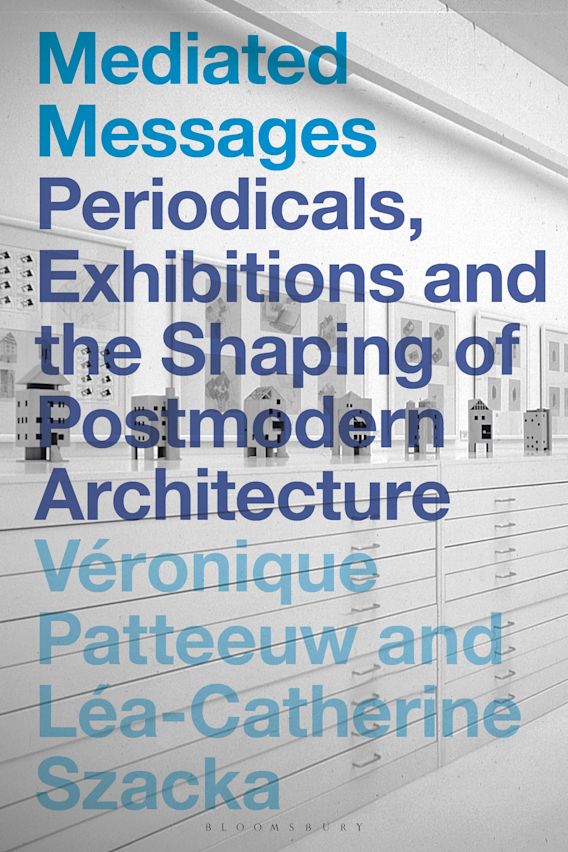Mediated Messages
Mediated Messages: Periodicals, Exhibitions and the Shaping of Postmodern ArchitectureEdited by Véronique Patteeuw and Léa-Catherine SzackaBloomsbury Visual Arts, June 2018Hardcover | 6 x 9 inches | 280 pages | 38 illustrations | English | ISBN: 9781350170032 | $39.95PUBLISHER'S DESCRIPTION:Mediated Messages presents a collection of original writing exploring the role played by the media in the development of postmodern architecture in the 1970s and 80s.The book's twelve chapters and case-studies examine a range of contemporary periodicals and exhibitions to explore their role in the postmodern. This focus on mediation as a key feature of architectural post-modernism, and the recognition that post-modernism grew out of developments in the media, opens up the possibility of an important new account of post-modernism distinct from existing narratives.Accompanied by a contextualizing introduction, the essays are arranged across four thematic sections (covering: images; international postmodernisms; high and low culture; and postmodern architects as theorists) and present a range of case-studies with a genuinely international scope. Altogether, this work makes a substantial contribution to the historical account of architectural postmodernism, and will be of great interest to researchers in postmodernism as well as those examining the role of the media in architectural history.Véronique Patteeuw is Associate Professor at ENSAP Lille. Léa-Catherine Szacka is Lecturer in Architectural Studies at The Manchester School of Architecture, University of Manchester.REFERRAL LINKS: dDAB COMMENTARY:The most influential book in architecture's turn from modernism to postmodernism is almost universally agreed upon to be Robert Venturi's Complexity and Contradiction in Architecture. Written mostly in 1962 but not published by the Museum of Modern Art until 1966, selections of the book were released in Perspecta 9/10, a 1965 double issue of the student-run Yale Architectural Journal that was edited by a young Robert A. M. Stern when he was working toward a master's degree in architecture at Yale. Among other things, the early peek at Venturi's watershed book in Perspecta signals the importance of periodicals, which can put out projects, criticism, and other architectural content faster than books, and often focus on innovative, young voices who might not otherwise garner the attention of publishers, Venturi notwithstanding.Yale's Perspecta is the subject of one of the dozen essays in Mediated Messages, which, as the subtitle indicates, examines periodicals and exhibitions in the shaping of postmodern architecture. Although the context of the chapter, "Charles Moore's Perspecta Essays: Towards Postmodern Eclecticism" by Patricia A. Morton, omits Venturi's text, part of the chapter does address issue 9/10, since that double issue is also famous for Moore's lengthy essay, "You Have to Pay for the Public Life." (It eventually became the name of a posthumous anthology of texts written by Moore.) Morton also looks at two essay Moore wrote before and after 9/10: "Hadrian's Villa" from Perspecta 6 (1960) and "Plug It In, Ramses, and See If It Lights Up, Because We Aren't Going to Keep It Unless It Works" from Perspecta 11 (1967). Morton's essay tracing Moore's critique of modernism and hist theory of "place" is a highlight in a book that is full of them.It's hard for me to single out a few other essays to highlight, since this happens to be a book that overlaps greatly with my interests, which now are more firmly entrenched in architectural media (e.g., books, exhibitions) than architectural practice. Véronique Patteeuw and Léa-Catherine Szacka, the latter responsible for a great book on the 1980 Venice Architecture Biennale, have assembled a great cast of architectural historians with interests that veer to publishing, exhibitions, and the like. Igor Marjanović, who co-wrote an excellent book on Alvin Boyarsky and the Architectural Association, is here, addressing the books and periodicals put out by the AA in the 1980s, focusing on the serial nature of their output. Irina Davidovici, another historian who wrote a book I really liked, focuses on the Swiss architecture magazine Archithese, which was launched under Stanislaus von Moos in 1971 and helped define the "Realism" that was basically the country's version of postmodernism. As a last example, Kim Förster, whose dissertation on the Institute for Architecture and Urban Studies (IAUS) will be published someday for wider dissemination, hones in on the journals and exhibitions produced by the IAUS in 1976.These essays by Marjanović, Davidovici, Morton, and Förster are respectively found in the book's four thematic chapters: "Postmodern Architecture's Pursuit of a New Spatial and Visual Culture: Architecture as Images Versus Image as Architecture," "International Postmodernisms: Micro-narratives and their Contribution to Postmodern Architecture," "Postmodern Architects as Thinkers:

Edited by Véronique Patteeuw and Léa-Catherine Szacka
Bloomsbury Visual Arts, June 2018
Hardcover | 6 x 9 inches | 280 pages | 38 illustrations | English | ISBN: 9781350170032 | $39.95
PUBLISHER'S DESCRIPTION:
REFERRAL LINKS:
PAGES:











